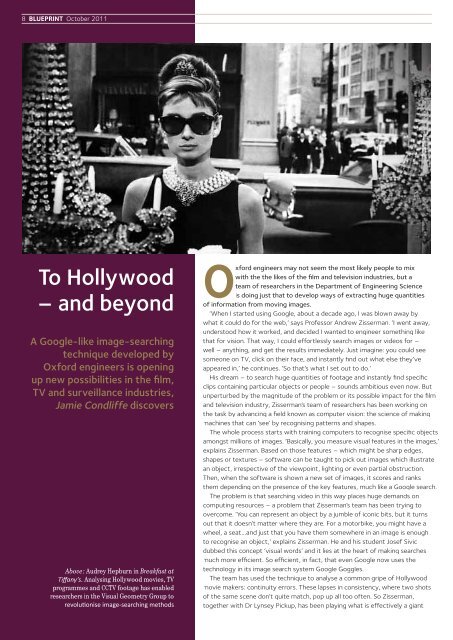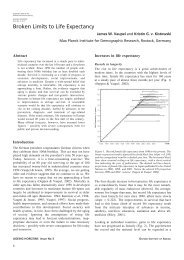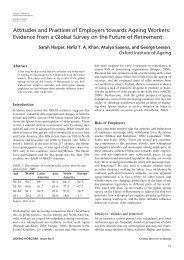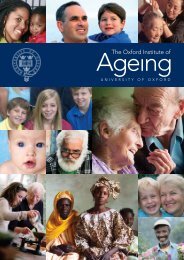Blueprint - October 2011 - Oxford Institute of Ageing - University of ...
Blueprint - October 2011 - Oxford Institute of Ageing - University of ...
Blueprint - October 2011 - Oxford Institute of Ageing - University of ...
Create successful ePaper yourself
Turn your PDF publications into a flip-book with our unique Google optimized e-Paper software.
8 BLUEPRINT <strong>October</strong> <strong>2011</strong><br />
To Hollywood<br />
– and beyond<br />
A Google-like image-searching<br />
technique developed by<br />
<strong>Oxford</strong> engineers is opening<br />
up new possibilities in the film,<br />
TV and surveillance industries,<br />
Jamie Condliffe discovers<br />
Above: Audrey Hepburn in Breakfast at<br />
. Analysing Hollywood movies, TV<br />
programmes and CCTV footage has enabled<br />
researchers in the Visual Geometry Group to<br />
<br />
<strong>Oxford</strong> engineers may not seem the most likely people to mix<br />
with the the likes <strong>of</strong> the film and television industries, but a<br />
team <strong>of</strong> researchers in the Department <strong>of</strong> Engineering Science<br />
is doing just that to develop ways <strong>of</strong> extracting huge quantities<br />
<strong>of</strong> information from moving images.<br />
‘When I started using Google, about a decade ago, I was blown away by<br />
what it could do for the web,’ says Pr<strong>of</strong>essor Andrew Zisserman. ‘I went away,<br />
understood how it worked, and decided I wanted to engineer something like<br />
that for vision. That way, I could effortlessly search images or videos for –<br />
well – anything, and get the results immediately. Just imagine: you could see<br />
someone on TV, click on their face, and instantly find out what else they’ve<br />
appeared in,’ he continues. ‘So that’s what I set out to do.’<br />
His dream – to search huge quantities <strong>of</strong> footage and instantly find specific<br />
clips containing particular objects or people – sounds ambitious even now. But<br />
unperturbed by the magnitude <strong>of</strong> the problem or its possible impact for the film<br />
and television industry, Zisserman’s team <strong>of</strong> researchers has been working on<br />
the task by advancing a field known as computer vision: the science <strong>of</strong> making<br />
machines that can ‘see’ by recognising patterns and shapes.<br />
The whole process starts with training computers to recognise specific objects<br />
amongst millions <strong>of</strong> images. ‘Basically, you measure visual features in the images,’<br />
explains Zisserman. Based on those features – which might be sharp edges,<br />
shapes or textures – s<strong>of</strong>tware can be taught to pick out images which illustrate<br />
an object, irrespective <strong>of</strong> the viewpoint, lighting or even partial obstruction.<br />
Then, when the s<strong>of</strong>tware is shown a new set <strong>of</strong> images, it scores and ranks<br />
them depending on the presence <strong>of</strong> the key features, much like a Google search.<br />
The problem is that searching video in this way places huge demands on<br />
computing resources – a problem that Zisserman’s team has been trying to<br />
overcome. ‘You can represent an object by a jumble <strong>of</strong> iconic bits, but it turns<br />
out that it doesn’t matter where they are. For a motorbike, you might have a<br />
wheel, a seat...and just that you have them somewhere in an image is enough<br />
to recognise an object,’ explains Zisserman. He and his student Josef Sivic<br />
dubbed this concept ‘visual words’ and it lies at the heart <strong>of</strong> making searches<br />
much more efficient. So efficient, in fact, that even Google now uses the<br />
technology in its image search system Google Goggles.<br />
The team has used the technique to analyse a common gripe <strong>of</strong> Hollywood<br />
movie makers: continuity errors. These lapses in consistency, where two shots<br />
<strong>of</strong> the same scene don’t quite match, pop up all too <strong>of</strong>ten. So Zisserman,<br />
together with Dr Lynsey Pickup, has been playing what is effectively a giant




![ORAL PRESENTATIONS [pdf] - Oxford Institute of Ageing](https://img.yumpu.com/37918222/1/184x260/oral-presentations-pdf-oxford-institute-of-ageing.jpg?quality=85)





